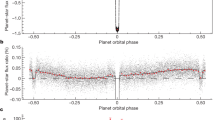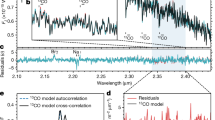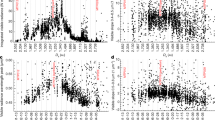Abstract
BOTH naked eye and photographic observations of the visible surface of the planet Jupiter reveal the presence of regions of contrasting and variegated colours. The bands, belts and spots—particularly the Great Red Spot—exhibit characteristic coloration which must indicate differences in molecular composition from place to place at the level of the Jovian clouds. All spectroscopic searches for characteristic spectral features unique to a band, belt or spot have been negative. For example, the Great Red Spot appears spectroscopically as enhanced continuous absorption at short wavelengths with no other identifying spectral features at the resolving powers used. The variable appearance of the Jovian cloud coloration suggests that the molecules responsible are synthesized in certain locales, transported, and dissociated in other locales. Were the coloured compounds produced by a planet-wide thermodynamic equilibrium, the planet should show a generally uniform coloration. Micro-meteoritic infall should provide a small steady-state abundance of certain minerals; however, it seems highly implausible that such minerals would be differentially distributed over the clouds of Jupiter in such a way as to explain the coloration. A more plausible source of chromophores would appear to be the chief atmospheric constituents themselves, thus implying that the coloration is caused by the presence of organic matter at the cloud level of Jupiter1,2.
This is a preview of subscription content, access via your institution
Access options
Subscribe to this journal
Receive 51 print issues and online access
$199.00 per year
only $3.90 per issue
Buy this article
- Purchase on Springer Link
- Instant access to full article PDF
Prices may be subject to local taxes which are calculated during checkout
Similar content being viewed by others
References
Urey, H. C., The Planets: Their Origin and Development (Yale University Press, New Haven, 1952).
Sagan, C., Proc. XI Internat. Astrophys. Colloq., Liége, 506 (1963).
Sagan, C., and Miller, S. L., Astron. J., 65, 499 (1960).
Fox, S., The Origins of Prebiological Systems (Academic Press, New York, 1965).
Lippincott, E. R., Eck, R. V., Dayhoff, M. O., and Sagan, C., Astrophys. J. (in the press) (February, 1967).
Ponnamperuma, C., Icarus, 5, 450 (1966).
Eck, R. V., Lippincott, E. R., Dayhoff, M. O., and Pratt, Y. T., Science 153, 628 (1966).
Author information
Authors and Affiliations
Rights and permissions
About this article
Cite this article
SAGAN, C., LIPPINCOTT, E., DAYHOFF, M. et al. Organic Molecules and the Coloration of Jupiter. Nature 213, 273–274 (1967). https://doi.org/10.1038/213273a0
Received:
Issue Date:
DOI: https://doi.org/10.1038/213273a0
This article is cited by
-
Jovian lightning whistles a new tune
Nature Astronomy (2018)
-
Margaret Oakley Dayhoff 1925–1983
Bulletin of Mathematical Biology (1984)
-
Evidence for lightning on Venus
Nature (1979)
-
The origin of life in a cosmic context
Origins of Life (1974)
-
Interstellar Organic Chemistry
Nature (1972)
Comments
By submitting a comment you agree to abide by our Terms and Community Guidelines. If you find something abusive or that does not comply with our terms or guidelines please flag it as inappropriate.



